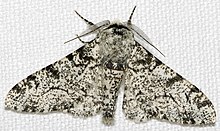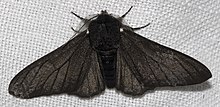Industrial melanism
Industrial melanism describes a variant of melanism , that is, a particularly pronounced storage of dark pigments - especially melanin - in the cells of the skin . The name came about after the peppered moth ( Biston betularia ), a moth , end of the 19th century in English of his external appearance was observed industrial areas, a drastic change: Had previously, the individuals of a light morph dominated thereafter occurred predominantly dark-colored individuals on, so-called carbonaria morphs.
Industrial melanism is a prime example of the fact that environmental changes can strongly influence the course of tribal history within a very short period of time. A genetic analysis published in 2011 came to the conclusion that all carbonaria morphs have the same allele (“singular origin”) and that this allele has only emerged more recently.
The historical background
Black moths are typically brightly colored and therefore (when they sit on the equally bright bark of birch trees ) they can hardly be distinguished from the ground even at close range. This camouflage - a protection against predators - failed when, as a result of the dramatic air pollution from factory chimneys at the time, the birch trees were increasingly darkened by soot and the lichens that settled on them were killed. In 1848 a large number of dark-colored specimens were observed for the first time near Manchester . As early as 1895, 98 percent of all moths in the industrial area near Manchester were colored dark. The frequency distribution of their external appearance also changed in a comparable way in at least 70 other butterfly species .
Since the 1960s, the proportion of melanistic variants in the English industrial regions - parallel to the reduction in air pollution - has decreased again considerably. The slightly higher proportion of the dark shape at the beginning of the 21st century compared to the initial situation in the 19th century is attributed by researchers to the fact that the birch trees are still rarely populated by lichens in many places due to the still existing pollution of the air with exhaust gases and the bright individuals therefore still do not find optimal living conditions.
Doubts about the interpretation of the observations
A common misconception is that the moth can be found mostly on the bark of tree trunks during the day. The error was caused by photos in various textbooks on ecology and evolutionary research, which showed white specimens on dark tree trunks and dark specimens on light tree trunks. However, these photos did not depict free-living specimens, but rather came from certain experiments that were repeated several times from 1953 onwards. In fact, the proportion of moths that rest on tree trunks during the day is roughly a third: In a study, 135 dormant individuals were found, 48 of them on tree trunks, 70 on horizontal branches (mostly on the lower half) and 17 on or under branches.
Such experiments on industrial melanism were first published in 1955 by Bernard Kettlewell , a zoologist from Oxford University , who tested a hypothesis formulated in 1896 by butterfly expert James William Tutt (1858–1911). In 1953 and 1955, Kettlewell exposed hundreds of moths of both colors to tree trunks in the morning hours in the heavily polluted town of Rubery near Birmingham and in unpolluted areas of Dorset , where the animals usually immediately went to rest. In the evening, Kettlewell used butterfly traps to determine the frequency of distribution of both color variants and found that in Birmingham he was able to capture twice as many dark and light variants, while in Dorset the ratio was exactly the opposite.
His study was met with disbelief among specialist colleagues, as neither lepidopterists nor ornithologists viewed birds as relevant predators of moths. Therefore, Kettlewell asked the behaviorist and experienced wildlife photographer and filmmaker Nikolaas Tinbergen to document a repetition of the experiments. As a result, a film documentary was actually published by Tinbergen in 1958, which convincingly demonstrated that light-colored butterflies on dark bark are more frequently discovered and consumed by birds than dark individuals.
It was only in 1998 that Michael Majerus, a geneticist at Cambridge University , pointed out that these experiments were not convincing evidence of the natural processes that had led to a shift in the ratio of light to dark individuals: the ecological connections (the moths' overnight accommodation) were not given sufficient attention and the prey behavior of the birds was inappropriately promoted by an oversupply of butterflies. In addition, the relativization of the selection pressure by diurnal birds by the non-selective nocturnal hunting by bats was not sufficiently included in the studies.
Majerus' criticism of Kettlewell's approach was sharpened by a journalist in a popular science book in 2002 : She accused Kettlewell of scientific fraud . The evolution researcher Jerry Coyne ( University of Chicago ) immediately rejected this allegation in the journal Nature , but Majerus' professional criticism and the popular science book were used by creationists as evidence of a great evolutionary fraud.
A long-term study
In 2002 Michael Majerus began a five-year field study to test the hypothesis again, this time close to nature, according to which the frequency of the light and dark moth forms is influenced by the prey of birds. This study was explicitly designed to cover all criticisms of Kettlewell's experimental design that had been raised up to that point. In Madlingley Wood, west of Cambridge, in different parts of 103 light and lichen-covered birches, wild-colored and melanistic moths were exposed in the same frequency ratio that they had in the wild population at that time (initially about 12 percent melanistic); At the end of the test series, 97 of them were still available (storm losses). All animals released, around 800 per year, came from the region in which they were also released; their density in the test area was not excessive compared to normal conditions, they were only released during their natural period of activity. Males and females, bred animals and re-released wild animals were analyzed separately. The animals were released in large cages at dusk so that they could choose a resting place for themselves at sunrise, and the cage was then removed. The dormant moths were revisited after four hours, and existing and missing due to predation by birds were noted (the tensioners are inactive in daylight and do not move). The result of this very elaborate experiment was: The melanistic form averaged 29.2 percent, and the light form 21.2 percent. This gives a selection coefficient of 0.22 against the melanistic form. The frequency of the melanistic form decreased in the same area in the study period (2002 to 2007) from 12 percent to a good one percent; this would result in a conversion coefficient of 0.29 compared to the melanistic form. The differences between these coefficients are not statistically significant. It can thus be considered to be proven that predation by birds is a sufficient reason to explain the observed decline in the melanistic form on the again light-colored trees. In addition, a number of birds were observed directly attacking resting moths, including robins , tree sparrows , great tit , blue tit and blackbird during the experiment .
However, it is still unclear which additional factors influence the frequency distribution of both moth forms. The dark form has always been relatively common in East Anglia , although there has never been particularly high air pollution.
The controversies about the causes of industrial melanism in the birch moth are repeatedly used by creationists to question the mechanisms of evolution . However, an incomplete interpretation of the causes for the frequency of occurrence of color variants in the birch moth has no evidential value in this context, because a change in ecological influencing variables (of so-called environmental factors ) is even taken into account by the critics of the theory of industrial melanism.
Genetic basis
The specific identity and type of sequence difference were established in 2016. A British research group who published the findings in Nature showed that the mutation event that led to industrial melanism was the insertion of a large transposable element into the first intron of a gene called the cortex . The researchers write in Nature : “We have begun to break down the mode of action of the carbonaria element by showing that it increases the frequency of a cortex transcript, the protein product of which plays an important role in cell cycle regulation. Our results fill a major knowledge gap in the iconic example of microevolutionary change and add another level of insight into the mechanism of adaptation in response to natural selection. The discovery that the mutation itself is a transposable element will stimulate further debate about the importance of 'jumping genes' as a source of great phenotypic novelty. "
Individual evidence
- ^ Arjen E. van't Hof et al: Industrial Melanism in British Peppered Moths Has a Singular and Recent Mutational Origin. In: Science . Volume 332, No. 6032, 2011, pp. 958-960, doi : 10.1126 / science.1203043
- ^ Klaus Lunau: Warning, camouflaging, deceiving. Mimicry and other survival strategies in nature. Wissenschaftliche Buchgesellschaft, Darmstadt 2002, p. 115, ISBN 3-534-14633-6
- ↑ a b Michael EN Majerus (2009): Industrial Melanism in the Peppered Moth, Biston betularia: An Excellent Teaching Example of Darwinian Evolution in Action. In: Evolution: Education and Outreach. (2009) 2: 63-74. doi : 10.1007 / s12052-008-0107-y
- ^ Henry Bernard Davis Kettlewell: Selection experiments in industrial melanism in the Lepidoptera. In: Heredity. Volume 9, 1955, pp. 323-342, ISSN 0018-067X
- ↑ Jaap de Roode: The moths of war. In: New Scientist . Volume 196 (2633) of December 8, 2007, p. 46
- ↑ Michael EN Majerus: Melanism: Evolution in action. Oxford University Press, 1998, ISBN 0-19-854983-0 , book text
- ↑ Axel Hausmann: Fascination Biodiversity. In: Eva-Maria Herzog, Hans-Christian Bauer (Ed.): Focus: Darwin. Are Darwin's Theories Still Valid Today? Salzburg 2011, pp. 11–31 (series of lectures at the University of Salzburg )
- ^ Judith Hooper: Of Moths and Men: An Evolutionary Tale: The Untold Story of Science and the Peppered Moth. London: Fourth Estate, 2002 (Reprinted by WW Norton & Company, 2003, ISBN 0-393-32525-3 )
- ↑ Jerry A. Coyne: Evolution under pressure. In: Nature . Volume 418, 2002, pp. 19-20, doi : 10.1038 / 418019a - Coyne had et al. a. noted that industrial melanism is still a great example of the process of evolution ("a splendid example of evolution in action")
- ↑ Jaap de Roode: The moths of war , p. 49
- ^ Arjen E. van't Hof, Pascal Campagne, Daniel J. Rigden et al .: The industrial melanism mutation in British peppered moths is a transposable element. In: Nature . Volume 534, 2016, pp. 102-105, doi: 10.1038 / nature17951 , full text

